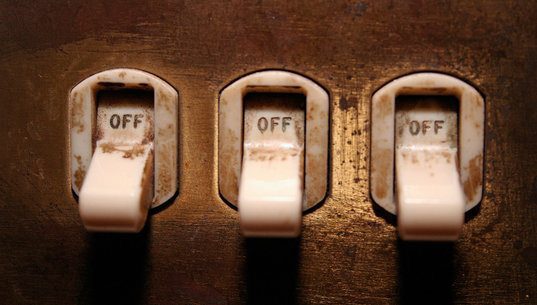“Let him who is without sin cast the first stone”
Evidence based decisions lead to good policy
Energy security is an important topic. We all want the lights to stay on. We all want our internet, our mobile phones and mostly want our cars to work.
So has our electricity and gas energy security increased or reduced over the past few years? Let’s start by compared FY14 the last year of the Carbon tax with some combination of FY16 and the forward outlook measured by Futures prices.

Electricity prices are sharply higher under current policies than they were. This clearly implies lower energy security. Despite raising $6 bn gross of Federal Govt. revenue, prices were still lower under the former system.

Gas and REC prices are sharply higher and this is clear evidence of lower energy security. You can certainly say that the higher gas prices are the result of policies made years ago but nothing has been done to change the situation. If the “Government” wanted to improve gas supply it could work towards a use it or lose it policy. There are undeveloped reserves in Qld.
Generation closures and investments: 3.5 GW of coal fired power closed in the last 3 years, and there was significantly reduced gas capacity factors over the last 3 years
It pays to look at the capacity factors rather than the headline MWs. Still of the list below Wallerawang was something like 5% of the NSW energy market when closed, Hazelwood is 20% of the Victorian market and Northern Power Station was significant in South Australia. The cumulative impact is fairly significant as shown by the electricity price.

Gas plants have reduced output. As is being increasingly well understood, combined cycle gas plants are poor investments in Australia. Gas is expensive and CCG is not suited to the stop start nature of wind dominated markets.
It might be different if we had a lot more gas plants but in the actual generation mix gas is a loser. Each of the plants that has reduced capacity factor has a different owner. So all those owners have come to the same conclusion. We should add that the 170 MW Smithfield Cogen facility is scheduled to close this year.

The overall new generation investment picture is well portrayed by the AER, in its “State of the Market Report”. The next edition is not due for a couple months but data up to the end of FY15 paints the following picture. This looks only at MW and not energy. Basically, in terms of energy, we need 2MW of renewable for ever 1 MW of coal closed. Nothing like that is being achieved and as a result energy security is reducing.

The last new gas capacity came on line in 2012, the last new coal capacity in FY2007 (and would have been started years earlier). Before that for coal we have to go back to FY2003.
Other evidence
We don’t need to draw attention to the overseas developments. Anyone reading this knows that whether it’s India, China, the USA or Europe coal fired generation is being de emphasized and renewables emphasized. This is not happening in a straight line and it is not happening without a struggle in each and every region but it is happening.
We can also look at policies of the major thermal generators in Australia.
AGL, by far the largest thermal generator has a policy of closing down all its coal plants by 2050.
Engie wants to move from thermal to renewables in Australia.
CLP is on the lookout for new renewable plants.
Origin states it is in favour of decarbonization and believes its short generation strategy is an advantage.
The Queensland Govt, which owns most of the thermal generation in Qld, plans to move to 50% renewables by 2040.
COP 21 target and Ultra Super Critical emissions factor
Australia’s COP 21 target is to reduce emissions by 26-28% relative to 2005 levels. We are supposed, according to the minister, to be on track for this but in fact emissions are fractionally higher in 2016 than in 2005. So where is the evidence to support the assertion that we are on track?
What policies do we have? Only the RET target. This is definitely better than nothing but it’s not a very well thought out policy. We went through the problems with the scheme previously: what’s wrong with the RET and nothing that has happened since would alter the conclusion that targeted reverse auctions are a far more effective way to procure new generation.
The RET target isn’t even enough in stationary energy, and stationary energy is less than 40% of Australia’s emissions. So where is the rest of the policy suite?
Instead of a policy at the moment we have the Federal Enegy and Environment Minister talking about moving to Ultra Super Critical generation. Below is a quote from the Minister as reported in today’s online version of “The Australian”
“The average amount of emissions across the Australian national electricity market today is about 820kgs of CO2 per megawatt hour produced. Now, if you were to go an ultra-supercritical black coal power plant — which means higher steam levels, greater efficiencies — you would reduce that to about 700kgs of CO2 per megawatt hour. If you were to go to a combined cycle gas power plant, then it would be under 400kgs of CO2.”
Its definitional that reducing CO2 output from 0.8 T per MWh to 0.7 T per MWh by moving everything to USC won’t achieve our COP 21 target. Not to mention the cost. And not to mention that Australia’s current COP 21 target is clearly and demonstrably not enough to do our share of keeping global warming to 2C.
If we moved the entire generation system to combined cycle gas then yes that would reduce emissions. But despite the AEMC and Frontier Economics modelling I doubt if there is even one senior management person in the Australian electricity industry that believes that is actually going to happen.
Conclusion
When the Abbott Govt was first elected it sent out a call to industry to invest in more coal generation plants and to announce that there would be substantial reduction in the Renewable Energy Target.
The result of that call has been
- A material part of the coal generation capacity has closed
- No new coal or gas plants have been proposed
- A fall in industry confidence and in generation investment
- a fall in electricity reliablity.
- A very obvious rise in electricity prices,
- higher gas prices (not due to that policy but impacts on policy)
- Higher REC prices
- A credibility gap with the electricity industry. By playing towards the “thermal lobby” the Government loses industry credibility. A loss of credibility effectively means that the industry will look elsewhere. Nearly all the Generation industry have strong international links and they see that Federal Policy is just not where the industry is going.
The major players in the generation industry have little or no intellectual support for policy directed towards USC and CCS thermal generation and certainly wouldn’t put a $ of investment towards it without lots of financial comfort and contracts.
Hearing the new Energy and Enviroment Minister, some one long on intellectual capability, putting forward a call that seems to echo the Abbott call of a few short years ago means a further erosion of support. And its surprising that the political instinct is so poor.
The industry would fall over itself to support a credible policy. On both sides of politics and certainly in business there any number of parties who can see a way forward based around renewable energy.
A nice gradual transition driven by specific and targeted quantities of new renewables backed by long term contracts that allow the industry to plan for a 20 and 30 year future and is consistent with out international obligations, our self interest and common sense. It is so easy, but seems to be so hard.
David Leitch is principal of ITK. He was formerly a Utility Analyst for leading investment banks over the past 30 years. The views expressed are his own. Please note our new section, Energy Markets, which will include analysis from Leitch on the energy markets and broader energy issues. And also note our live generation widget, and the APVI solar contribution.







